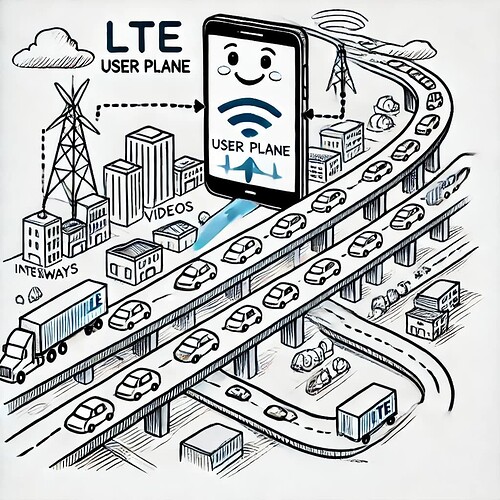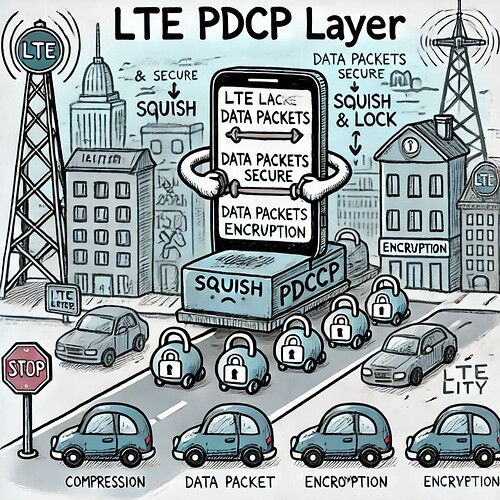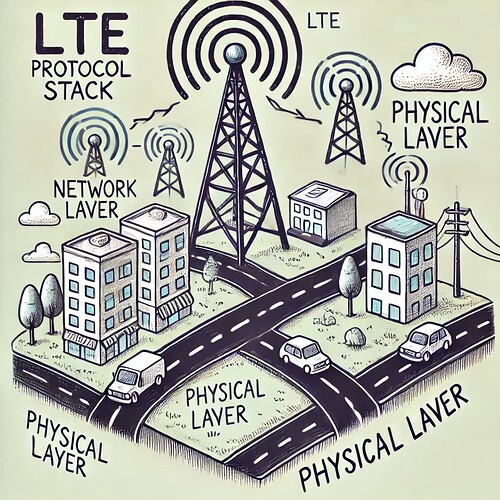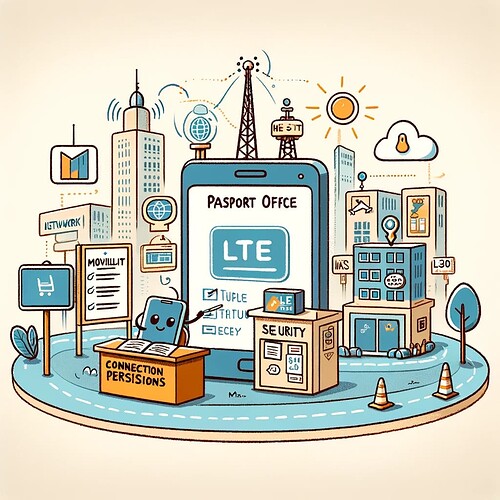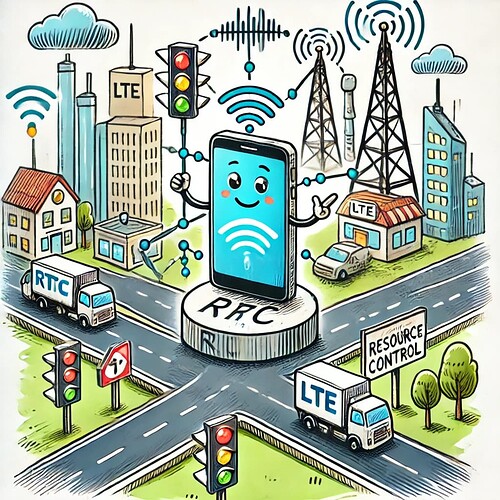This topic presents in a very simplified way all the main concepts that should be understood by those who know LTE.
LTE Protocol Stacks
The LTE Protocol Stacks are like layers of communication in your phone, each managing different types of information flowing between your device and the network. There are two ways of communication, or “main planes”: the User Plane and the Control Plane. The User Plane handles the actual data you use, like browsing the internet, streaming videos, or downloading files - focusing on efficient content delivery. In contrast, the Control Plane manages the instructions that keep the network running smoothly, such as setting up calls, managing connections, and ensuring security. Together, these planes work to ensure you receive data while maintaining a reliable and secure connection, allowing your phone to stay connected, secure, and capable of providing high-quality data services while handling the complex requirements of a cellular network.
![]() The LTE Protocol Stacks in LTE city have two main parts, just like how a city has places for people to do things and places to manage the city’s operations. These two main paths for communication are called the User Plane and the Control Plane. The User Plane is like the part of the city that delivers things you use - focused on bringing you the content you want, like videos or messages, as quickly as possible. While the Control Plane is the background work keeping everything organized and connected, as the city’s management team, handling all the behind-the-scenes work to keep connections smooth and secure, like setting up the delivery routes, managing who can enter the city, keeping traffic smooth, and ensuring everyone’s safe. Together, these planes ensure you get your data reliably while keeping everything organized and safe.
The LTE Protocol Stacks in LTE city have two main parts, just like how a city has places for people to do things and places to manage the city’s operations. These two main paths for communication are called the User Plane and the Control Plane. The User Plane is like the part of the city that delivers things you use - focused on bringing you the content you want, like videos or messages, as quickly as possible. While the Control Plane is the background work keeping everything organized and connected, as the city’s management team, handling all the behind-the-scenes work to keep connections smooth and secure, like setting up the delivery routes, managing who can enter the city, keeping traffic smooth, and ensuring everyone’s safe. Together, these planes ensure you get your data reliably while keeping everything organized and safe.
Skip to: Roadmap to LTE
User Plane
The User Plane in LTE is responsible for managing all the actual data that you use, like streaming videos, browsing, or sending files. It’s responsible for transmitting user data, such as internet browsing, streaming, and voice calls, between your device and the network.
![]() User Plane (For the Things You Use), is like your phone’s delivery service. This part handles the fun stuff you want, like sending and receiving videos, messages, and games. It is like the highways and roads in our city. It’s where all the cars (data) travel to get from one place to another, carrying information like internet browsing, streaming, and phone calls. Think of it as the path that all your data travels on to reach its destination. You can also think of this as the part of the city where packages are prepared and sent out to people, and each layer in this stack has a specific job.
User Plane (For the Things You Use), is like your phone’s delivery service. This part handles the fun stuff you want, like sending and receiving videos, messages, and games. It is like the highways and roads in our city. It’s where all the cars (data) travel to get from one place to another, carrying information like internet browsing, streaming, and phone calls. Think of it as the path that all your data travels on to reach its destination. You can also think of this as the part of the city where packages are prepared and sent out to people, and each layer in this stack has a specific job.
- Search Forum
 LTE User Plane
LTE User Plane 
PDCP Layer
PDCP (Packet Data Convergence Protocol) layer handles tasks like compressing and securing the data. It makes sure the data is lightweight enough for efficient delivery and that it stays private through encryption. PDCP also reorders packets, so everything you see on your screen is in the right order, making your online experience seamless.
![]() PDCP Layer (Package Security & Compression) acts like a “squish and lock” machine - it makes data smaller to fit better and locks it so only you can open it. It is like the traffic controller who ensures all cars (data packets) are in order, not too many cars on the road, and everything is moving smoothly. It also keeps the cars safe by encrypting them.
PDCP Layer (Package Security & Compression) acts like a “squish and lock” machine - it makes data smaller to fit better and locks it so only you can open it. It is like the traffic controller who ensures all cars (data packets) are in order, not too many cars on the road, and everything is moving smoothly. It also keeps the cars safe by encrypting them.
- Search Forum
 LTE PDCP layer
LTE PDCP layer 
RLC Layer
RLC (Radio Link Control) layer focuses on organizing the data into manageable packets and keeping them error-free. It handles the segmentation and reassembly of data packets, ensures error correction, and manages data retransmission to maintain reliable communication.
![]() RLC Layer (Organizing Packages) acts as the “package sorter” - it breaks up big files into smaller ones for easier delivery and puts them back together on the other side. Like the quality control at the city’s border. It checks cars (data packets) to ensure they’re not damaged, fixes them if needed, and keeps everything in the right order. It ensures data packets are sent in the correct order and check for errors. If there’s an issue, it can request a re-send.
RLC Layer (Organizing Packages) acts as the “package sorter” - it breaks up big files into smaller ones for easier delivery and puts them back together on the other side. Like the quality control at the city’s border. It checks cars (data packets) to ensure they’re not damaged, fixes them if needed, and keeps everything in the right order. It ensures data packets are sent in the correct order and check for errors. If there’s an issue, it can request a re-send.
- Search Forum
 LTE RLC layer
LTE RLC layer 
MAC Layer
MAC (Medium Access Control) layer divides network resources between users and ensures that everyone has a fair share. This layer is crucial for handling multiple devices connecting to the network at the same time. It manages how data is sent over the radio channels, scheduling transmissions, and controlling access to the physical medium.
![]() MAC Layer (Distribution Center) acts as the “traffic controller” and decides when each package goes out, making sure everyone gets their turn. Like the gatekeeper at toll booths, deciding which cars (data) get to enter the road first, scheduling and controlling how data flows through the network - who gets to send data and when.
MAC Layer (Distribution Center) acts as the “traffic controller” and decides when each package goes out, making sure everyone gets their turn. Like the gatekeeper at toll booths, deciding which cars (data) get to enter the road first, scheduling and controlling how data flows through the network - who gets to send data and when.
- Search Forum
 LTE MAC layer
LTE MAC layer 
Physical Layer
The Physical layer is the foundation that actually transmits and receives the radio waves carrying your data. It deals with the raw, low-level details, like how signals are sent over the air, making sure your data moves through the network efficiently. It handles the actual transmission of data over the airwaves, converting digital data into radio signals that can be sent and received by your device and the network’s cell towers.
![]() The Physical layer (The road itself) is like the actual road the data travels on, sending packages through the air from the network to your phone. It’s the foundation where all the cars (data) drive, making sure they can physically get from one place to another.
The Physical layer (The road itself) is like the actual road the data travels on, sending packages through the air from the network to your phone. It’s the foundation where all the cars (data) drive, making sure they can physically get from one place to another.
- Search Forum
 LTE Physical layer
LTE Physical layer 
Control Plane
The Control Plane takes care of the instructions and setups needed for the network to function. It manages everything from setting up and maintaining calls to handling network security. This layer doesn’t deal with your data directly but ensures that the connections are organized, stable, and secure. It handles signaling and control information between your device and the network.
![]() Control Plane (For Behind-the-Scenes Work) is like your phone’s way of chatting with the city’s control center to keep everything in order. It doesn’t handle fun stuff like videos, but it makes sure your phone stays connected and ready. It is like the city’s traffic management system. It handles all the signals, signs, and instructions that keep traffic (data) moving smoothly and safely, ensuring that data transmission pathways are efficiently managed and maintained.
Control Plane (For Behind-the-Scenes Work) is like your phone’s way of chatting with the city’s control center to keep everything in order. It doesn’t handle fun stuff like videos, but it makes sure your phone stays connected and ready. It is like the city’s traffic management system. It handles all the signals, signs, and instructions that keep traffic (data) moving smoothly and safely, ensuring that data transmission pathways are efficiently managed and maintained.
- Search Forum
 LTE Control Plane
LTE Control Plane 
NAS Layer
NAS (Non-Access Stratum) layer handles the higher-level functions, like authentication, mobility management, and session management. It ensures that your phone is connected to the right network and manages activities like roaming. NAS keeps the connection secure and ensures your phone has the right permissions to stay connected.
![]() NAS Layer (Network Instructions) is like a “passport office,” helping your phone check in, keeping track of where it is, and ensuring only allowed phones can connect. Like the city’s administrative office. It manages important tasks like mobility (moving around the city), sessions (meetings), and security.
NAS Layer (Network Instructions) is like a “passport office,” helping your phone check in, keeping track of where it is, and ensuring only allowed phones can connect. Like the city’s administrative office. It manages important tasks like mobility (moving around the city), sessions (meetings), and security.
- Search Forum
 LTE NAS layer
LTE NAS layer 
RRC Layer
RRC (Radio Resource Control) layer is responsible for managing the connection between your phone and the network at the radio level. It controls how resources are allocated, sets up the connection, and manages handovers between cells as you move. RRC ensures your device has a stable and optimized connection to the network. It manages the setup, maintenance, and release of radio resources, controlling how data sessions are established and maintained, and ensuring efficient use of the network’s resources.
![]() RRC Layer (Connection Manager) is the “connection helper” that makes sure your phone has a strong signal, switches to a better tower if needed, and stays connected while you’re on the move. Like the city’s traffic lights and signs. It helps set up and maintain the roads for cars (data), ensuring efficient use of the roads (network resources) and keeping everything organized.
RRC Layer (Connection Manager) is the “connection helper” that makes sure your phone has a strong signal, switches to a better tower if needed, and stays connected while you’re on the move. Like the city’s traffic lights and signs. It helps set up and maintain the roads for cars (data), ensuring efficient use of the roads (network resources) and keeping everything organized.
- Search Forum
 LTE RRC layer
LTE RRC layer 
That’s it. ![]()
-
Continue reading: Roadmap to LTE - Signaling Procedures
-
Or back to: Roadmap to LTE

